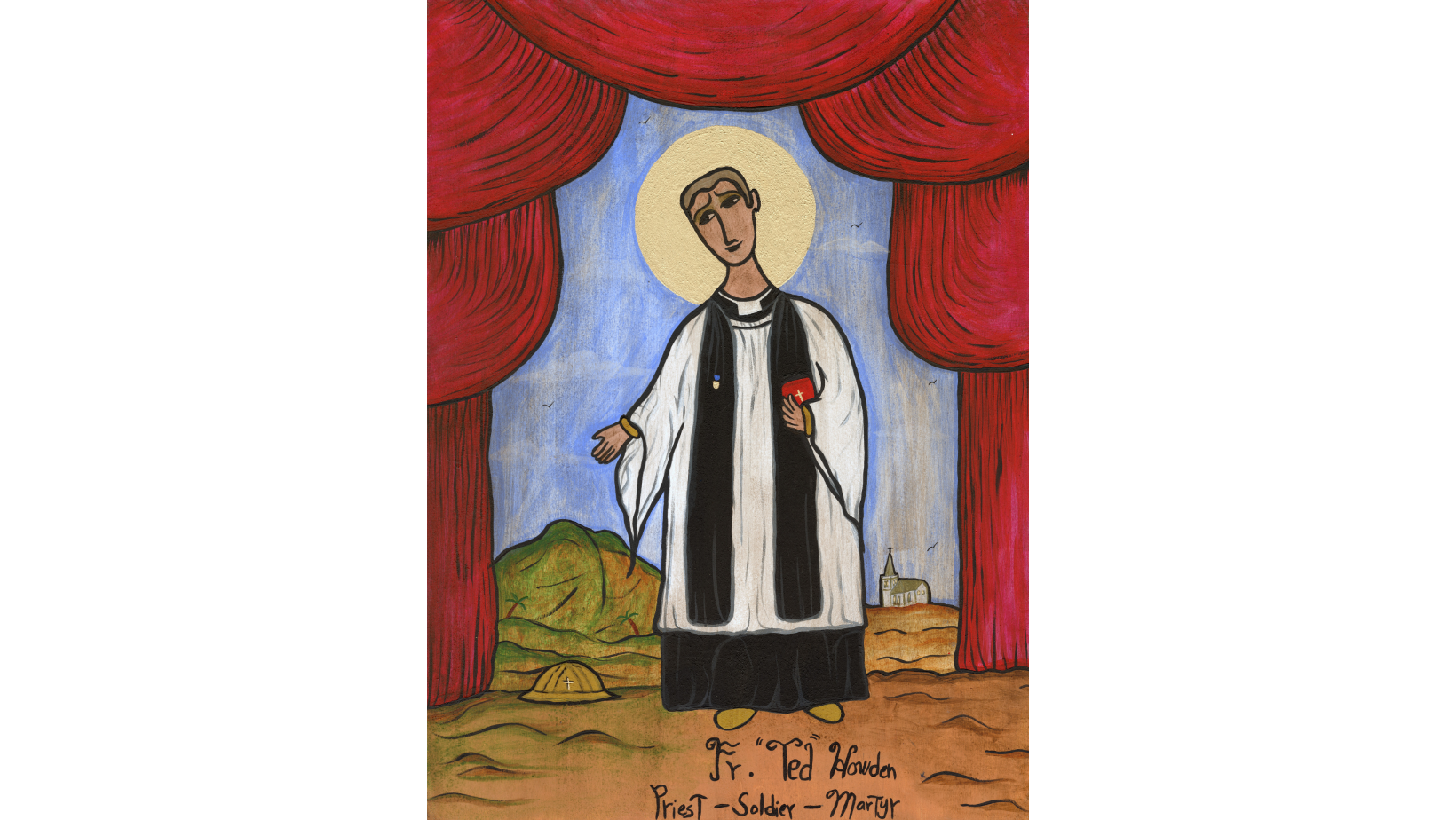Angel Gabriel Roque
Symbolism in the Retablo of Fr. Ted Howden:
The Red Curtain: The red curtain is a tradition in the history of commissioning religious artwork. In centuries past, it was difficult and expensive to transport artwork to the Americas from Spain. Many towns did not have churches, and many churches were sparse and devoid of painted objects of Catholic devotion. The people started creating their own religious art, and this new style of painting and images unique to New Mexico became known as retablo, and the maker, a santero. Since the artwork was expensive, professional art materials were not available; the colors were made from a mix of organic powders and egg yolk. The owner of the retablo would often protect the work from the desert sun by draping it with a curtain. Even though new art materials are now widely available, the curtain continues to appear in retablos to honor the old tradition.
In this specific retablo, the curtain is large and bright red to signify the martyrdom of Fr. Ted and to symbolize love for his example.The curtain’s red hue was chosen carefully to emulate the red of the curtains of the stations-of-the-cross retablos at the Cathedral of St. John in Albuquerque, New Mexico. St. John is the seat of the Bishop of the Diocese of the Rio Grande, Fr. Ted’s home diocese.
Vestments: Fr. Ted appears in Anglican choir dress, including a cassock (black vestment), Anglican surplice (white robe), and tippet (black scarf). These vestments were worn by Fr. Ted while working as a vicar in Roswell, New Mexico.
Military Medal: On the right side of Fr. Ted’s tippet, you will notice a small military medal. This medal was placed on his tippet to symbolize the 200th Coast artillery regiment, the regiment in which Fr. Ted served as captain and chaplain. This is also the regiment that endured the Bataan Death March where he was martyred. The medal was given to the then-survivors of the march after their release and arrival in New Mexico.
Prayer Book: In his left hand, Fr. Ted carries a book that symbolizes the first Book of Common Prayer that arrived in the Missionary District of New Mexico and southwest Texas. The side of the retablo where the prayer book appears symbolizes Roswell, New Mexico, where Fr. Ted served.
Mount Mariveles: On Fr. Ted’s right side is Mount Mariveles, a dormant stratovolcano and the highest mountain point in the province of Bataan in the Philippines, where the Bataan Death March began. This side of the retablo symbolizes Bataan in the Philippines, where Fr. Ted served and was martyred.
Helmet: On Fr. Ted’s right, you will find a helmet on the ground far away from Mount Mariveles. This symbolizes his place of martyrdom in the Davao Penal Colony. A golden cross has been painted on the helmet to highlight Fr. Ted’s work as a chaplain.
Church: On Fr. Ted’s left is St. Andrews Episcopal Church in Roswell, New Mexico, which was Fr. Ted’s first call as an Episcopal priest.
The ground: Fr. Ted is standing on Bataan, represented to Fr. Ted’s right, and New Mexico and Texas, to his left. These represent both his place of martyrdom and his home diocese. During Fr. Ted’s time, the DRG was the Missionary District of New Mexico and Southwest Texas, where Fr. Ted’s father, Bishop Frederick Bingham Howden (1914–1940), was Missionary Bishop. Today the Missionary District of New Mexico and Southwest Texas is the Episcopal Diocese of The Rio Grande.
Collect:
Almighty God, our strength and sustenance, you gave your servant Frederick Howden the grace and courage to put the need and hunger of others before his own life and health. Inspire us with directness of purpose in the training of body, mind, and spirit, that we may better serve you, our country and others. Give us the vision to know what is right and the courage to pursue it. Strengthen us with your spirit for the duties of life, that we may continue your faithful servants and at the last enter your heavenly kingdom: through Jesus Christ our Lord, who lives and reigns with you and the Holy Spirit, one God forever and ever. Amen.
Angel Roque



